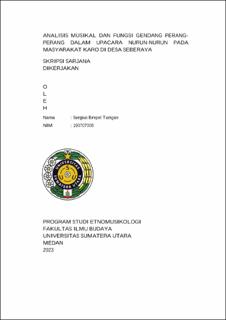Analisis Musikal dan Fungsi Gendang Perangperang dalam Upacara Nurun-Nurun pada Masyarakat Karo di Desa Seberaya
Musical Analysis and Function of Gendang Perangperang in The Nurun-Nurun Ceremony in The Karo Community Seberaya Village

Date
2023Author
Tarigan, Sergius Brepel
Advisor(s)
Tarigan, Kumalo
Arifninetrirosa
Metadata
Show full item recordAbstract
Gendang perang-pereang is one of the repertoire from the Karo area,
the musical instrument used in this song is the gendang sarune. These gendang
perang-perang are played before the traditional nurun-nurun event begins.
Gendang perang-perang is played to honor the ancestral spirits around the event
venue, in other words, this music is played for the invisible (si la idah) so that
later the event can run smoothly and is also played to unite the games of simalu
gung, simalu penganak, penggual and also dancers. This research aims to
describe the stages of the nurun nurun ceremony in the Karo community in
Seberaya village, describe the function of the gendang perang-perang in the
nurun-nurun ceremony in the Karo community in Seberaya village and describe
the musical structure of the gendang perang-perang. In this research the author
uses the basics of music analysis approach introduced by William P. Malm to
study the function of gendang perang-perang using the Use and Function theory
of music pioneered by Allan P.Merriam. The research method used is a
descriptive qualitative research method. The results obtained from this research
are that the nurun-nurun ceremony stage consists of two stages, namely stages
based on place, including at home, in the jambur, in the cemetery and stages
consisting of two stages, namely stages based on place, including at home, in the
jambur, in the cemetery and stages based on time, namely the preparation stage,
the day of the ceremony and after the traditional ceremony. These gendang
perang-perang have several musical functions, namely continuity functions,
validation functions of social institutions, communication functions, and functions
related to social norms. Musical analysis of the gendang perang-perang has the
basic note do=b and the contour of the gendang perang-perang is a pendulous
contour, namely the movement of the curved melody, namely going up and down
(twisting) from a low note to a higher note then back again to a low note.
Gendang perang-perang have five forms, namely form A which can be further
divided into three phrases, form B, one phrase, form C, one phrase, form D, one
phrase, and form E, one phrase as the final/closing part or also better known as
Karo. known as the buku gendang. For tempo, the gendang perang-perang is
played with three tempo changes, namely twice increasing and once decreasing.
Collections
- Undergraduate Theses [308]
